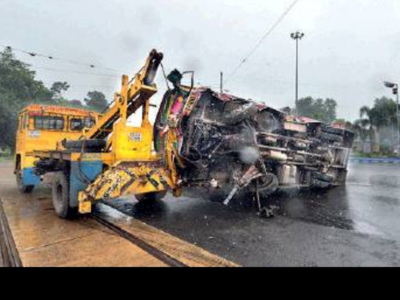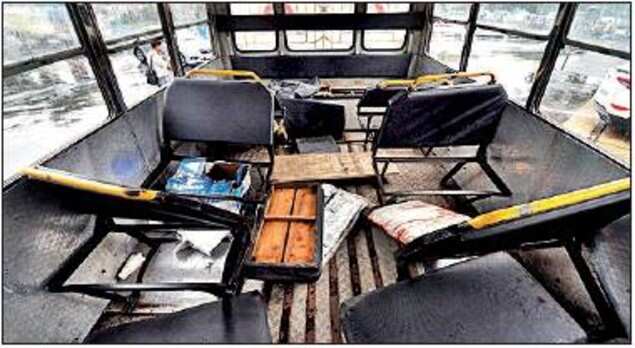Top Searches
- News
- City News
- kolkata News
- Kolkata: ‘Rash driving, snag from disuse possible reasons’
Kolkata: ‘Rash driving, snag from disuse possible reasons’

The mini-bus being towed away
KOLKATA: The mini-bus accident on Red Road on Thursday, in which constable Vivekananda Deb lost his life, could have been caused by the driver’s negligence or a mechanical failure from disuse for past 45 days, police said. So many people on the bus were injured because the seats were wrenched off the vehicle floor and the passengers were violently flung forward.
Also, the driver of the mini-bus was rash, given that 89 traffic rule violation cases had been recorded against the private carrier in the 15 months it had been operating, police said.

Bus manufacturers, who saw the photographs of the interior of the bus after the accident, said injuries on the vehicle could have been a lot less had it been a factory-fitted bus instead of a chassis, on which a fabricated body was fitted with weak welding and screws. “Buses now manufactured don’t come apart. The bodywork that was not even done at a proper workshop disintegrated in the impact,” said an executive of a bus manufacturing firm.
Those in the industry pointed out that the accident might have happened due to a mechanical failure, caused either because the bus was parked for over a month and a half or because of poor maintenance due to lack of earning. “An owner has to spend at least Rs 15,000-Rs 20,000 to make an idle bus road worthy. Several issues occur when a bus does not operate for so many days. The brake shoe can get jammed, the constant waterlogging can damage tyres. Lubricant needs to be changed. Even basic servicing becomes necessary. This mini-bus was one of three vehicles on the Metiabruz-Howrah route that operated as others were not ready to ply,” said Pradip Narayan Bose of West Bengal Bus Minibus Owners’ Association.
Transport experts agreed that buses, which remained parked for one-and-a-half months under the sky, on waterlogged streets, would invariably falter on the road and might pose danger to people, apart from own drivers, conductors and passengers. “After suspension of movement for the past one-and-a-half months, the tyres are supposed to lose gripping power. These buses need to undergo fitness tests before hitting roads. Otherwise, the accident by the mini-bus near Fort William East Gate will recur,” said Prabir Bose, an automobile engineering expert. Also, if the fuel injector was clogged, the axle could break away and a disastrous accident could happen, even vehicles could turn turtle, he said. Three things must be checked very thoroughly before allowing a bus to hit the road -- fuel injectors, engine piston, brake and tyres, Bose added.
Swapan Ghosh, joint secretary of Minibus Operators’ Coordination Committee, did not agree. “The owner, Khurshid Alam of Metiabruz, has years of experience and maintains his fleet well. This is a new bus that has run barely seven months. My theory is that it was the driver’s error. While turning left into Dufferin Road at high speed, he saw the bike at the last moment. He then hit the brake hard and lost control,” said Ghosh.
Also, the driver of the mini-bus was rash, given that 89 traffic rule violation cases had been recorded against the private carrier in the 15 months it had been operating, police said.

Bus manufacturers, who saw the photographs of the interior of the bus after the accident, said injuries on the vehicle could have been a lot less had it been a factory-fitted bus instead of a chassis, on which a fabricated body was fitted with weak welding and screws. “Buses now manufactured don’t come apart. The bodywork that was not even done at a proper workshop disintegrated in the impact,” said an executive of a bus manufacturing firm.
Those in the industry pointed out that the accident might have happened due to a mechanical failure, caused either because the bus was parked for over a month and a half or because of poor maintenance due to lack of earning. “An owner has to spend at least Rs 15,000-Rs 20,000 to make an idle bus road worthy. Several issues occur when a bus does not operate for so many days. The brake shoe can get jammed, the constant waterlogging can damage tyres. Lubricant needs to be changed. Even basic servicing becomes necessary. This mini-bus was one of three vehicles on the Metiabruz-Howrah route that operated as others were not ready to ply,” said Pradip Narayan Bose of West Bengal Bus Minibus Owners’ Association.
Transport experts agreed that buses, which remained parked for one-and-a-half months under the sky, on waterlogged streets, would invariably falter on the road and might pose danger to people, apart from own drivers, conductors and passengers. “After suspension of movement for the past one-and-a-half months, the tyres are supposed to lose gripping power. These buses need to undergo fitness tests before hitting roads. Otherwise, the accident by the mini-bus near Fort William East Gate will recur,” said Prabir Bose, an automobile engineering expert. Also, if the fuel injector was clogged, the axle could break away and a disastrous accident could happen, even vehicles could turn turtle, he said. Three things must be checked very thoroughly before allowing a bus to hit the road -- fuel injectors, engine piston, brake and tyres, Bose added.
Swapan Ghosh, joint secretary of Minibus Operators’ Coordination Committee, did not agree. “The owner, Khurshid Alam of Metiabruz, has years of experience and maintains his fleet well. This is a new bus that has run barely seven months. My theory is that it was the driver’s error. While turning left into Dufferin Road at high speed, he saw the bike at the last moment. He then hit the brake hard and lost control,” said Ghosh.
FacebookTwitterLinkedinEMail
Start a Conversation
end of article
